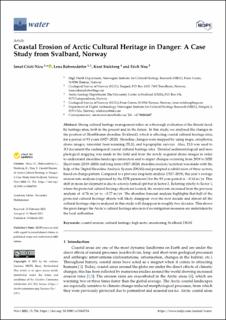| dc.description.abstract | Strong cultural heritage management relies on a thorough evaluation of the threats faced by heritage sites, both in the present and in the future. In this study, we analysed the changes in the position of Hiorthhamn shoreline (Svalbard), which is affecting coastal cultural heritage sites, for a period of 93 years (1927–2020). Shoreline changes were mapped by using maps, ortophotos, drone images, terrestrial laser scanning (TLS), and topographic surveys. Also, TLS was used to 3D document the endangered coastal cultural heritage sites. Detailed sedimentological and morphological mapping was made in the field and from the newly acquired drone images in order to understand shoreline-landscape interaction and to depict changes occurring from 2019 to 2020. Short-term (2019–2020) and long-term (1927–2020) shoreline erosion/accretion was made with the help of the Digital Shoreline Analysis System (DSAS) and prompted a subdivision of three sectors, based on change pattern. Compared to a previous long-term analysis (1927–2019), this year’s average erosion rate analysis (expressed by the EPR parameter) for the 93-year period is −0.14 m/yr. This shift in mean development is due to a newly formed spit-bar in Sector 2. Referring strictly to Sector 1, where the protected cultural heritage objects are located, the erosion rate increased from the previous analysis of –0.76 m/yr to −0.77 m/yr. The shoreline forecast analysis highlights that half of the protected cultural heritage objects will likely disappear over the next decade and almost all the cultural heritage objects analysed in this study will disappear in roughly two decades. This shows the great danger the Arctic’s cultural heritage sites is in if no mitigation measures are undertaken by the local authorities. | |
